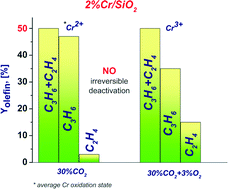Towards efficient catalysts for the oxidative dehydrogenation of propane in the presence of CO2: Cr/SiO2 systems prepared by direct hydrothermal synthesis†
Abstract
Cr/SiO2 catalysts (Cr loading in the 0.25–2.0 wt% range) have been prepared by direct hydrothermal synthesis in the presence of templating agents, in order to attain porous systems with high specific surface area (in the 600–1000 m2 g−1 range), and then characterized and tested in the oxidative dehydrogenation of propane in the presence of CO2 or CO2 + O2 as an oxidant. The extent and regularity of mesopores decreased significantly by increasing the Cr content (X-ray diffraction, N2 adsorption, transmission electron microscopy), but this did not limit the catalytic performances of the catalysts with higher Cr loadings. In all cases, the only chromium species found were surface chromates (diffuse reflectance electronic spectroscopy and X-ray absorption near edge spectroscopy), accompanied by Brønsted acid centres (infrared spectra of adsorbed NH3). All catalysts appeared stable towards irreversible deactivation, even after ca. 900 min of testing, and propene yields as high as 40% were attained. The combination of spectroscopic and catalytic results allowed us to rationalize, at least in part, the role of different oxidants in defining the chromium oxidation state, and a tentative correlation of the oxidation state of Cr species during the reaction (Cr2+/Cr3+) with selectivity to propene is suggested.

- This article is part of the themed collection: 2016 most accessed Catalysis Science and Technology articles

 Please wait while we load your content...
Please wait while we load your content...